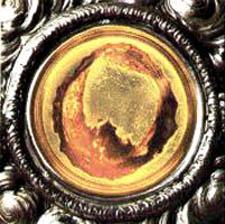 |
Commentaries on Saints
Transfiguration of Our Lord – August 6
Father Paul Sretenovic

The Transfiguration of Our Lord
|
A reminder of the Transfiguration of Our Lord Jesus Christ to the three Apostles, Peter, James, and John, can be found in the Mass when Jesus is lifted up by the priest for all to adore Him, as was the case for the Apostles, who bowed before the Divinity. In fact, just as Moses and Elias bore witness to the divinity of Christ on Mount Tabor, so also the angels, although invisible, are present at every Consecration of bread and wine into the Body and Blood of Our Lord.
Granted, the types of miracles are different. In the first, awe comes much more naturally, given Jesus’ change in appearance, not to mention the presence of the two Old Testament figures. Yet, the second miracle is more significant because ordinary substances are transformed into God Himself.
There have been cases in Church History, however, where God has intervened to make the Real Presence of Jesus in the Eucharist apparent to the naked eye as the visible Body and Blood of Christ and to give the faithful a sense of awe rivaling that of Peter, James, and John as Christ was transfigured before them. We call these phenomena "Eucharistic miracles," during which, at the time of the Consecration, the bread and wine not only change their substance to become the Body and Blood of Our Lord but also they become externally visible to the eyes as such.
In some of the Eucharist miracles I am referring to, the Host gives place to the figure of the Infant Jesus, whose Body is then held up by the priest. Does this mean that Jesus is any more present than He would have been had the Consecration happened as usual?

The miracle of Lanciano, Italy: the Host, was transformed into flesh & blood. Below, after examination the flesh & blood type are human
 |
In substance, both the presences - with or without miracle - are the same. Likewise Jesus was substantially the same in His normal life and in the Transfiguration to the Apostles on Mount Tabor. What was added in the latter was the visible confirmation of his Divinity, which doubtlessly increases one's faith, hope, and charity.
You may recall that in an article two weeks ago, I mentioned that Our Lady appeared to both St. Dominic and to St. Simon Stock as a safeguard against her children falling prey to two enemies of the soul, pride and sensuality. Well, in similar fashion, I believe that God granted these Eucharistic miracles as armor for the faithful against the denial of the Real Presence by such influential heretics as Berengarius of Tours in the 11th century, and later by the Protestant heresiarchs during the Protestant Revolution of the 16th Century. Those miracles were occurring in the first two millennia of Christianity, and they could continue into the third as a reminder that Our Lord meant what He said when He told the Apostles in John's Gospel, "My flesh is true food and my blood is true drink."
Jesus was transfigured before the Apostles to strengthen their faith in His divinity because their faith would be shaken during His Passion, on Holy Thursday right through Good Friday. This miracle would not prevent St. Peter and St. James from falling, just as the Eucharistic miracles have not prevented even many faithful Catholics from having periods of doubt and darkness in their spiritual life. But it would prevent St. John from abandoning the way of the Cross. His fidelity, which relied on his closeness to Our Lady, certainly was strengthened by the remembrance of that glory he saw in the Transfiguration.
Remembering the ways in which Jesus has chosen to manifest Himself before the eyes of the Apostles and to certain privileged faithful helps us to remember His promise to be with us all days, and to overcome our doubts and discouragement along the "via dolorosa," which is what our day-to-day-life is.
Just as Ecumenical Councils have been called to deal with crises in Faith, the Transfiguration and Eucharistic miracles increase our certainty in the Divinity of Our Lord, which serves to prevent those crises.
Our faith should not have to rely only on miracles, but rather should depend upon our strong belief in the Divinity of Our Lord. Our charity should depend upon our willingness to be united with Jesus Christ and Mary on the way of the Cross at every moment of every day.
The Apostles would completely understand the gift of the Transfiguration only after they drank from the cup of Our Lord's sufferings. We should recall that this is precisely the promise of Our Divine Savior to St. James and St. John when He told them, "You will drink the cup from which I drink." Implied in this forewarning of Christ is not simply a sharing in His death, but also in the interior sufferings that they would have to endure for the sake of His Name.
We should remember this in our days especially, because to be faithful to the constant teaching and traditions of the Holy Catholic Church in our difficult days means we will have to share in the sufferings of Christ. He is inviting us today to drink from the cup which He drank from, the cup of being misunderstood, of isolation. It is not always easy, but we should remember that the final end for our fidelity now is to be united with him in the glory of Heaven. The Transfiguration reminds us of that, just as it would remind the Apostles and prepare them to fulfill their missions on earth in face of every adversity and suffering.

|
Saint of the Day | Home | Books | CDs | Search | Contact Us | Donate

© 2002- Tradition in Action, Inc. All Rights Reserved
|
 |

|